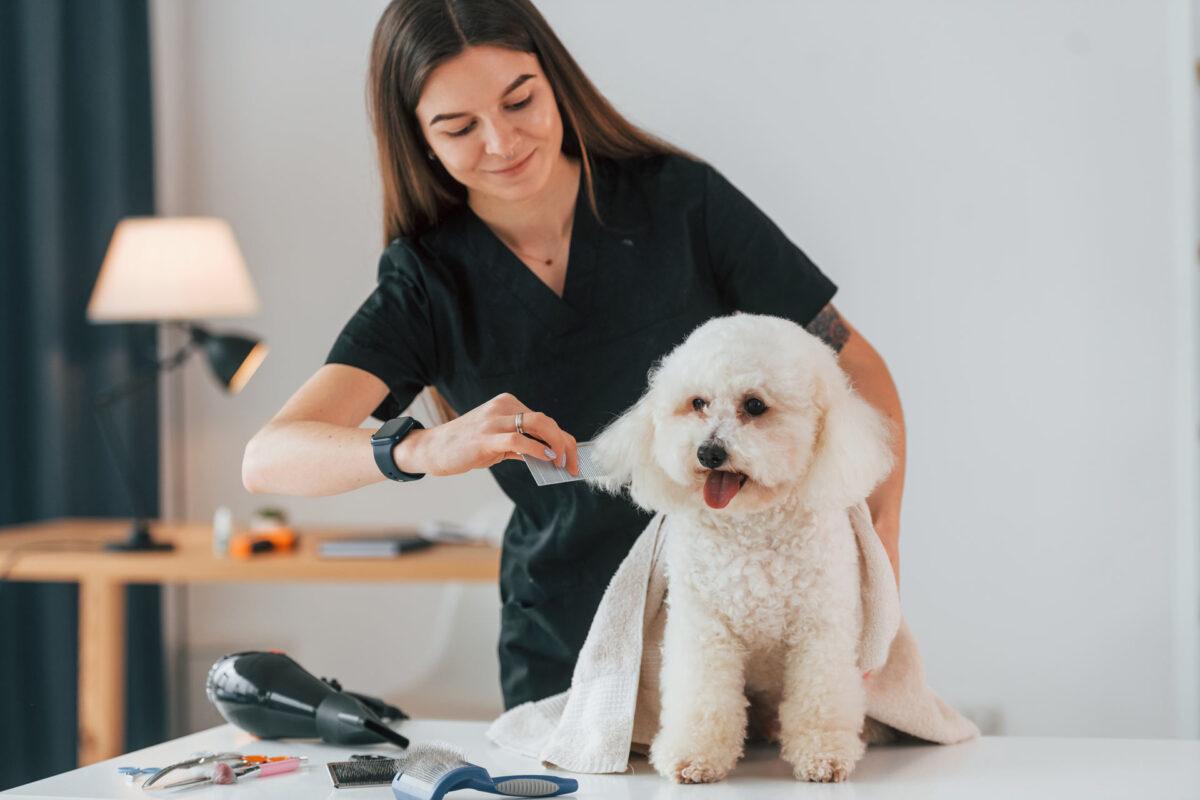The Ultimate Guide to Grooming A Dog With a Sensitive Skin

A well-groomed dog will appear and feel his best. Grooming procedures on a regular basis also allow you to inspect your dog’s coat, mouth, eyes, ears, nails and other areas for symptoms of disease. The frequency with which you should groom your dog is determined on his size, breed, coat type and skin sensitivity. While excellent hygiene habits are necessary for a healthy dog, most dogs, unlike people, do not require regular cleanliness and frequent grooming routines. What is necessary and how frequently your dog needs to be cleaned is determined by their breed. Afghan Hounds, Poodles, and Komondors, to mention a few, demand frequent grooming (but are well worth the effort), other breeds like the Beagle, Weimaraner, and Boxer allow for greater grooming flexibility. Teeth brushing, ear cleaning, nail cutting, and brushing are all necessary components of regular dog care, regardless of breed. Professional dog groomers, professional dog handlers, and some veterinary technicians have received extensive training in dog grooming services and care, so it is guaranteed that your pup is in good hands when bringing them to these people. However, it is, nevertheless, beneficial for owners to learn simple maintenance grooming in order to keep their pets, especially ones who have sensitive skin, looking sharp in between visits to the groomer. With that being said, here is the ultimate guide to grooming a dog with sensitive skin.
Brushing
A few brushing sessions each week will maintain the average dog’s hygiene and neatness; daily care is preferable. Regardless if your dog has sensitive skin, It is recommended that you brush down to the skin, allowing the massaging motion to increase blood circulation and loosen and remove dandruff particles.
The type of equipment required is determined on the texture and length of your dog’s coat. Pin brushes with long, round-ended stainless-steel or chrome-plated pins are required for longhaired pets. Bristle brushes are required for short-, medium-, and some long-coated dogs. Slicker brushes are also available for eliminating mats and dead hair, as are rubber curry combs for polishing smooth coats and removing dead hair. Clippers, stripping knives, rakes, hairdryers, and other grooming products also provide these functions.
You should also check for burrs and other tenacious plant debris when brushing; mats, which commonly form behind the ears and beneath the legs; and any scratches or scrapes on the skin itself. Furthermore, all dogs shed, but some shed far more than others. Brushing on a regular basis will help keep shedding in check.
Bathing
Depending on the breed, coat and skin sensitivity of your dog, regular, but not frequent, bathing are recommended. Washing too frequently destroys natural oils, causing the coat to become dry and rough, which can be extremely harmful to your skin-sensitive pet. When required, it is recommended that you use a gentle shampoo designed specifically for dogs. You must first place the dog in a tub or basin, then insert cotton balls and a few drops of mineral oil into his ears and eyes. After, you should wet the dog’s fur and apply shampoo from the neck back. After lathering and cleaning, thoroughly rinse your dog with warm water. You must make sure you do this step attentively and with care in order to make sure that there is no shampoo residue left in their coat. Finally, you must rub a towel vigorously and allow them to shake any excess off. If you still see that your dog is wet, you must blow-dry them. To go an extra step, you can brush or comb them.
Nail Trimming
To keep their feet healthy, it is best that you keep their nails short. Long nails obstruct the dog’s stride, making walking difficult or uncomfortable. They are also prone to breaking and if they do break, this will cause serious pain towards your dog. This generally occurs at the base of the nail, near blood vessels and nerves, and a broken nail necessitates a trip to the veterinarian. One way to know if your dogs are too long is if you can hear them clicking on the floor. To trim your dog’s nails on your own, you must use a specifically designed clipper. Most come with safety shields to keep you from cutting your nails too short. When maintaining your dog’s feet, you must trim only the ends of the nail, before the “quick,” which is a blood artery inside the nail. Only the hook-like section of the nail that turns down should be clipped.
Many dogs despise getting their nails cut. If your dog is one of them, you may make the operation less painful by introducing it to your dog when he is a puppy. Begin by carefully clipping a nail or two at a time, and your dog will realise that you are not going to injure him.
Ear and Eye Cleaning
You should clean your dog’s ears once a month, or more frequently if he has ear issues. Only use a moist towel or a cotton swab soaked in mineral oil to clean the outer area of the ear, especially if your dog’s skin is sensitive. Doctors recommend that you never put anything in your ear. Some dogs require the hair immediately well within ear to be plucked to keep air circulation; see your veterinarian if this is essential for your dog.
It is also important to clean your dog’s eyes at home. You must be very careful as this part of their body is very sensitive. In order to clean any minor discharges in their eyes, you must use a damp cotton ball. It is important that you avoid putting anything unpleasant into your dog’s eyes.
Tooth Brushing
It is very important that you brush your dog’s teeth on a regular basis with dog-specific toothbrushes and toothpaste. If your dog is resistant to getting his teeth cleaned, you can start by stroking their teeth and gums with your finger. Then, put some toothpaste on your finger and let them sniff and lick it; repeat with the toothbrush. Also make sure he has chew toys to help him clean his teeth. As your dog ages, he may develop tartar accumulation that needs professional cleaning by a veterinarian.
Cleaning your dog, especially if they have sensitive skin, is very important for their physical health and overall well-being. You must be extra careful though when cleaning your skin-sensitive dog and you must take extra precaution when completing your daily cleaning routine that should include brushing, bathing, nail trimming, ear and eye cleaning and tooth brushing. Some extra steps that you should take as an owner of a dog who has sensitive skin includes using dog-specific shampoo and appliances, brushing their coats gently and with care and making sure there is no left-over shampoo or products in their coats after showering. If you have further questions about grooming your dog at home, talk to your local, trusted veterinarian today!

